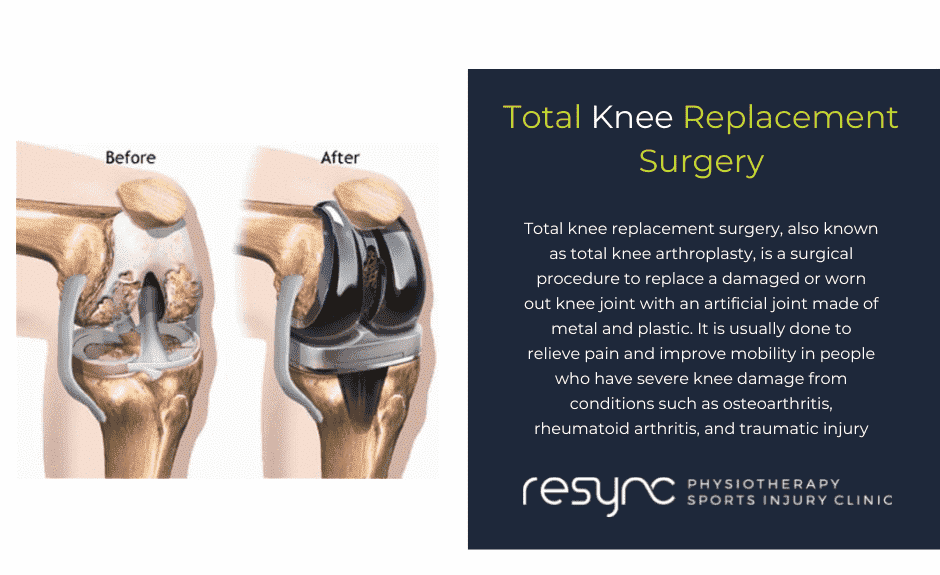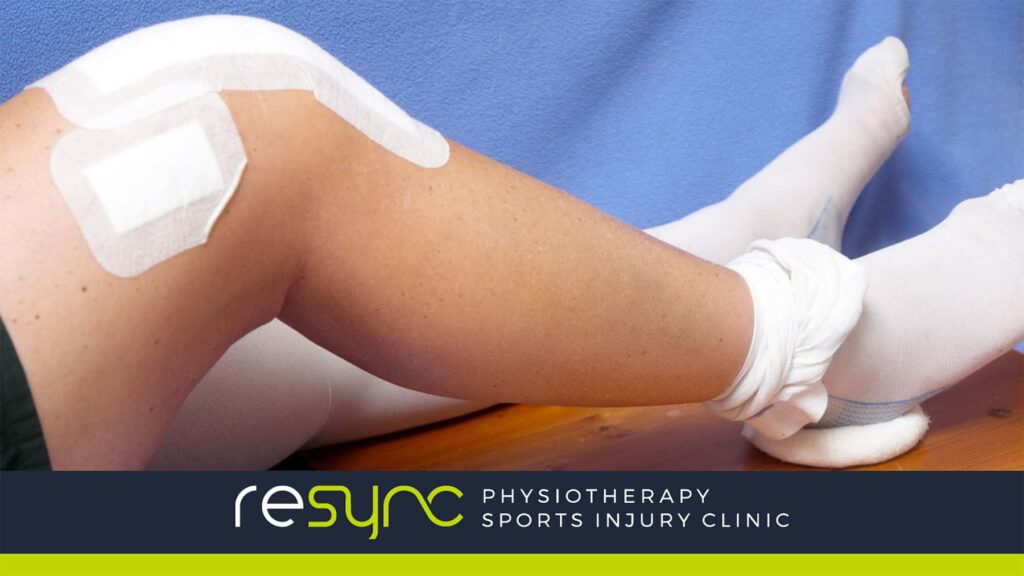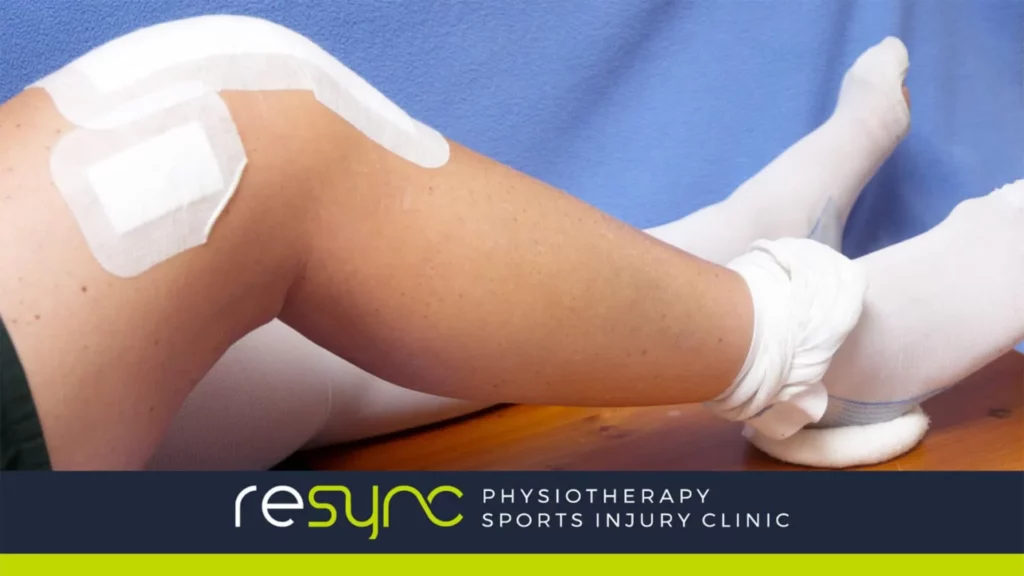The most common reason for knee replacement surgery is due to osteoarthritis. This means that the protective cartilage in the knee has worn away. When the damage is bad it can be very painful and difficult to perform simple activities like walking or climbing stairs.
Knee replacement surgery is also known as knee resurfacing as only the surface of the bones are replaced . The surgery involves replacing the damaged area of worn cartilage with a synthetic metal implant. Knee replacement surgery can relieve pain, help regain a straight leg and restore the function of the knee.
There are a few reasons why your doctor or surgeon may recommend surgery. People who can benefit from the knee replacements often have:
- Moderate to severe knee pain while resting and/or at night.
- Chronic knee inflammation and swelling.
- Severe stiffness that limits everyday activities and sturuggling to maintain a straight leg or other knee problems.
- Fail to improve with other treatments such as physical therapy, medications or cortisone injections.

Total Knee Replacement Post Op
Complication rates following a surgery is low. Major medical complications such as knee joint infection, stroke or heart attacks occur in less that 2% of patients.
You will feel some pain after the surgery and this is a natural part of the healing process. Pain management following your surgery is provided by the doctors throught prescribed medications.
Blood clots prevention is an essential part of the knee surgery post operation process. The surgeon may advise you to take a few measure to prvent a blood clot . These inclide taking blood thinners, wearing a compression boot or sock.
To prevent leg swelling and blood clotting , foot and ankle movemnets are also encouraged aftersurgery to increase blood flow in the leg muscles.
Your recovery from knee replacement surgery will largely depend on how well you follow you surgeons advice during the first few weeks after surgery.
Wound care is very important to prevent infection. You will have stiches or staples along the wound for several weeks after surgery.
Exercise is a vital part of recovering from surgery especially in the first few weeks after surgery. The 12 weeks after surgery are very important for the surgical leg to ensure a successful recovery.
You should be able to resume most normal activities on the surgical leg in the first 4 to 6 weeks after surgery. Some pain on activity and at night can be common for several weeks post op.
Your physical therapist (physiotherapist) will help you :
- Plan a progressive walking program to slowly increase your mobility and independance.
- Resume normal daily activities such as sitting , standing and walking up stairs.
- Restore the knees range of motion to get the leg straight and to slowly bend your knee.
- Encourage specific exercises to restore movement,knee strength and muscle strength.
Total Knee Replacement Exercises
Early post op exercises with physical therapy help increase blood circulation to the legs, improve knee movement and strengthen the muscles around the knee. Your physical therapist will help you witht he following exercises.
- Ankle pumps :
Lie on your back and move the foot up and down by contracting your calf and shin muscles. Perform for 2-3 minutes 2-3 times times and hour. - Straight leg raises :
Tighten your thigh muscles with the knee straight. Lift the leg several inches and hold for 10 seconds tehn slowly lower the leg back to the starting position. Repeat this until the thigh muscle feels fatigued or about 2-3 minutes. - Quadriceps sets :
Quadriceps sets involve tightening the quadriceps mucele for 10 seconds while trying to straighten the knee with a pillow under the heel. Repeat for 10 times in a 2 minute period or until the quadricep gets fatigued. - Bend your knee :
Lie on your back, keeping your heel on the ground or bed slide your heel towards your buttocks (knee flexion) . Hold the knee in the maximally bent position for 10 seconds then straighten the leg again to the starting position. Repeat for 10 times and 3 sets. You can use a towel around the lower leg to assist in knee flexion.
Knee Joint Replacement Healing time
When you have knee surgery the 12 weeks following surgery are very important in terms of rehab and recovery. It is important to follow a plan set out by your surgeon and physio. Rehabilitation begins on day 1 following surgery. Every patients recovery is uniqueand the recovery timelines may vary.
You should be able to stop using your crutches or walking frame and return to normal daily activities about 6 weeks after surgery. However , it can take up to 3 months for pain and swelling to settle down. The knee will continue to recover for up to 2 years on the operated knee.
Total Knee Replacement Walking
You should be able to walk short distances soon after knee surgery. This early recovery activity helps aid recovery and helps the knee regain strength and movemnet.
Walking
Proper walking is the best way to help your knee recover. At first, you will walk with a walker or crutches. Your surgeon or physical therapist will guide you on what to do.
- Try to walk as smoothly as possible
- Try to walk with the knee straight as the heel of the operated leg touches the floor.
- As you move forward the knee and ankle will naturally bend as the foot is flat on the floor.
- Remember, touch your heel first with the operated knee, then flatten your foot, then lift your toes off the floor.
- Always lead up the stairs with the good knee and down the stairs with the operated knee.
Total Knee Replacement Running
Many surgeons and doctors advice that patients with TKR avoid high impact activities like running. Running is an aerobic activity like walking so it is great for heart health and burning calories but it is much more high -impact. The amin concern among patients is that they will wearr out their implant. The evidence is not conclusive on weather patients should reurn to running but some people do.
We must also take into account age, weight and muscle strength.
Most of the time people who ran regularly pre-op do not go back to high impact activities such as running
Cycling, swimming and walking are great low impact activies to return to for general health post- op.
Knee Replacement Advanced exercises
Comitting to a rehabilitation plan guide by your physio will determine how well the knee works in the future. You will have significantly less stiffness and pain.
- Stationary Bike cycling: Helps with fitness and knee mobility.
- Heel Raise : Stant hip width apart, raise up on your toes to work the calf muscles and slowly return back to the floor , perform 3 to 4 sets of 12 repetitions.
- Chair squats: In standing, bend the knees to lower the hips down to a chair or box. Gradually increase the weigh that you hold. Stand back up until you fully staighten the knee. Perform 3 sets of 10 reps.
- Leg Balances: Stand on one leg for as long as possible while squeezing the gluteal muscles.
This Article was written by Conor Tierney Senior Therapist at Resync Physiotherapy
If you wish to book an appointment with Conor please CLICK HERE


